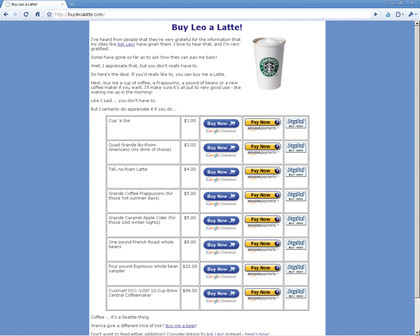
Did you know that your modest blog may be enough to provide you with a tiny trickle of cash? After an initial bit of effort, this is money for nothing.
You won't have to set up a brand new business, go cap in hand to investors or even create a new site. All you need to do is add some snippets of code to the site you already have and hope that your readers are feeling generous.
It's unlikely you'll make enough to live on (unless your blog is extremely popular), but it'll help pay the hosting bills at least.
We've picked methods that don't require any financial investment. All you need is the ability to cut and paste code into your blog template, membership to a few services and the will to make some extra cash.
So that you won't be wasting your time, we've chosen the most popular, tried-and-tested routes available.
1. Virtual begging
Bought out by Ebay in 2002, PayPal was already part of the web elite. Founded in 1998, PayPal started out as a 'virtual money' system. Over the years it has grown into a comprehensive transaction service, offering both personal and business users tools that enable them to make and receive payments over the internet.
Get daily insight, inspiration and deals in your inbox
Sign up for breaking news, reviews, opinion, top tech deals, and more.

It's become common practice for bloggers to place 'Donation' buttons on their sites – for payment at the discretion of the user. If your blog is popular enough to warrant an extra outlay on bandwidth and hosting, that's an indicator that you have a following loyal enough to help out at least a little.
Asking folks to 'buy' you a coffee or a beer might prove more successful though. If you already have a PayPal account, you'll need to upgrade it to Business or Premier by going to the Merchant Services section at www.paypal.com, then choosing 'Upgrade to a Business Account Now' in the Website Payments Standard section.
Log back into PayPal and click the 'Merchant Services' link again. In the Website Payments Standard section, click the 'Create a Donate Button' link.
2. Fill in the forms
You'll be taken to a threestage form. Here you can enter all the details of your payment, choose a donation amount, a unique ID for the payments – so that you can differentiate them from other money entering your account – and set currency and security features. You can also control the appearance of the button that will be pasted into your page.

When you've filled in the form, click 'Create Button Now'. You'll be taken to a page containing your custom HTML code.
Select it, copy it to the clipboard and paste it into your web layout. It's an HTML form, so you can directly edit any of the elements.
3. Selling goods
Donations might not be your thing, but you can choose to sell items on your blog via PayPal instead. The process for generating code is similar.
You sign up for a Business or Premier account as described. In the Web Payments Standard section, you can choose to have a button for a single item or one for multiple items. The multiple items button adds things to a PayPal cart.

This is effectively a fully hosted shopping system with no need to install any further software on your site. When customers place orders, you'll be notified by email and will then need to fulfil those orders yourself.